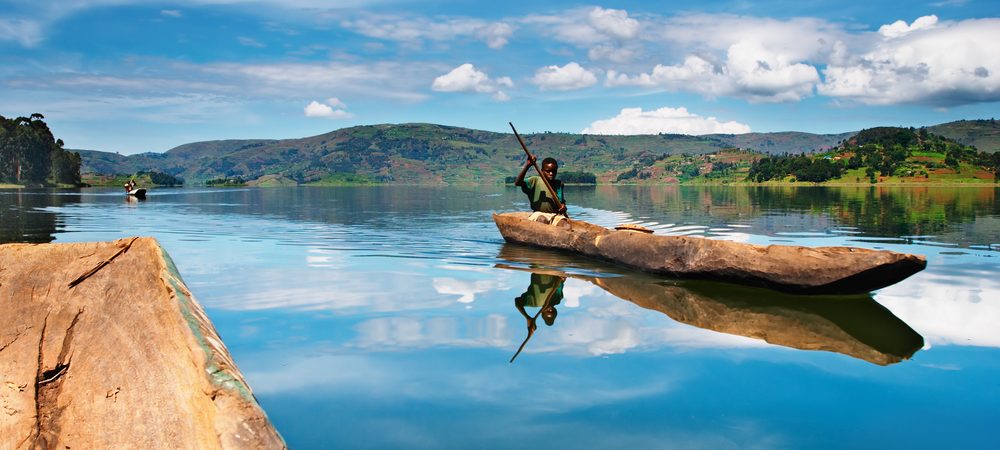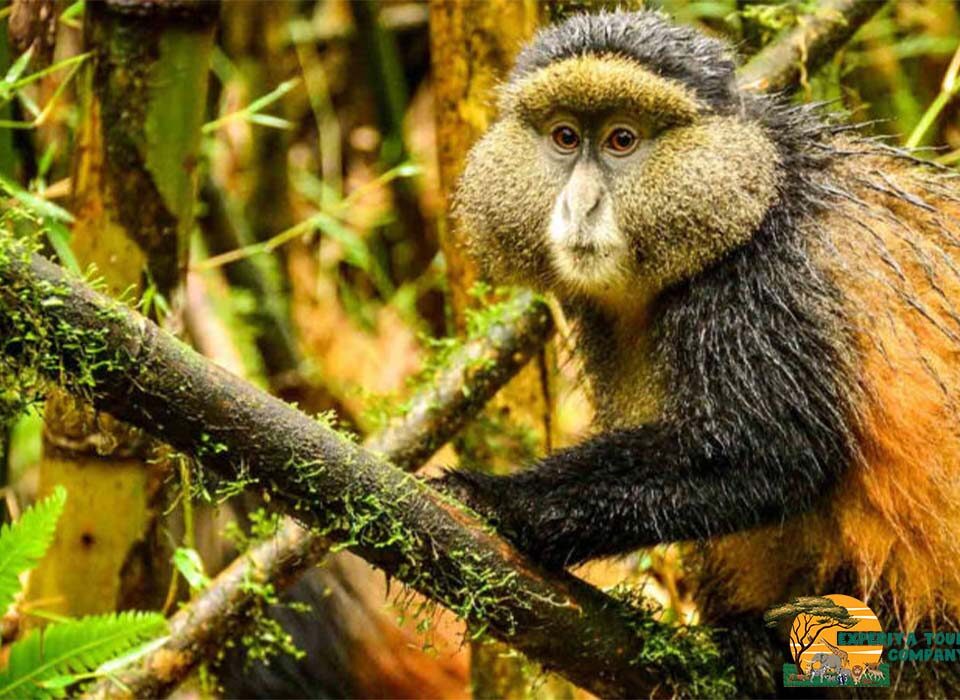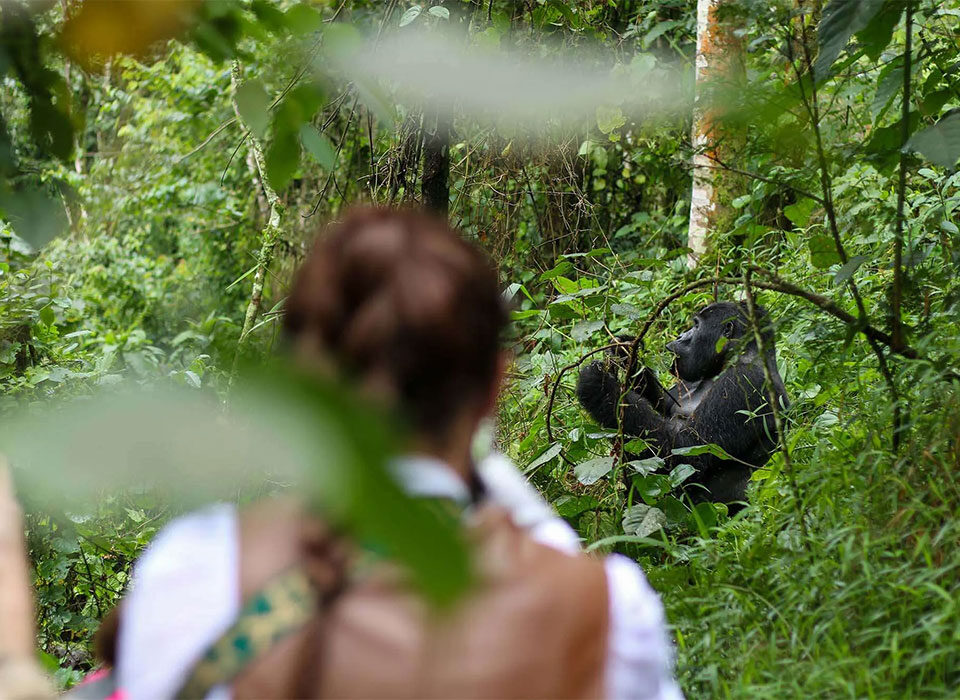
Can I Swim at Sipi Falls – Uganda’s Waterfall Adventure Explained
October 25, 2025
Is Lake Bunyonyi Safe for Swimming – Uganda’s Highland Paradise Explained
October 25, 2025What’s the Best Route to Explore Lake Bunyonyi – Travel Guide with Experiya Tour Company

What’s the Best Route to Explore Lake Bunyonyi?
Tucked deep within the rolling green hills of southwestern Uganda lies one of Africa’s most enchanting natural wonders — Lake Bunyonyi, a place so serene and picturesque that it feels like a dream. Its name, meaning “place of many little birds,” perfectly captures the tranquil rhythm of this highland paradise. Dotted with 29 islands of varying shapes and sizes, Lake Bunyonyi stretches across a landscape of terraced hillsides, misty mornings, and mirrored waters, offering travelers one of the most peaceful and scenic destinations in East Africa.
But with so many ways to reach and explore it, travelers often ask, “What’s the best route to explore Lake Bunyonyi?” The answer depends on where you’re coming from and how you’d like to experience it — whether you’re driving through Uganda’s countryside, combining it with gorilla trekking in Bwindi, or crossing over from Rwanda. In this guide, we’ll take you through the most scenic, convenient, and rewarding routes to Lake Bunyonyi, along with tips on how to make the most of your visit once you arrive.
Where Exactly Is Lake Bunyonyi?
Lake Bunyonyi lies in southwestern Uganda, near the town of Kabale, just 8 kilometers away. It’s surrounded by the highlands that border Rwanda, sitting at an elevation of about 1,962 meters above sea level, making it one of Africa’s highest lakes. The lake’s depth and beauty have made it legendary — it is said to be over 900 meters deep, although this figure remains debated among scientists. Regardless, its clear, calm waters and island-studded surface create a mesmerizing sight unlike anywhere else in Uganda.
Lake Bunyonyi is also special because it’s bilharzia-free and safe for swimming, which is rare in East Africa. The absence of dangerous wildlife such as crocodiles and hippos makes it an ideal spot for water-based activities like canoeing, kayaking, and swimming.
Route 1: From Kampala or Entebbe – The Classic Overland Journey
For most travelers starting their Uganda adventure from Kampala or Entebbe, the journey to Lake Bunyonyi is a long but incredibly scenic drive through the heart of the country.
The drive from Kampala to Lake Bunyonyi is approximately 410 kilometers, taking 7 to 9 hours depending on traffic and road conditions.
The most direct and popular route follows the Kampala–Masaka–Mbarara–Kabale road, which is fully paved and in good condition. Along the way, you’ll pass through charming towns and rural landscapes that showcase Uganda’s countryside at its best.
Key Stops and Highlights: The Equator Monument (Kayabwe) is a perfect stop for photos and souvenirs, located about 77 km from Kampala. You can also enjoy a cup of coffee at one of the cafés nearby. Masaka Town is a busy trading town ideal for a lunch stop or fuel refill. Mbarara City, known as the “Land of Milk and Honey,” offers modern amenities, restaurants, and hotels if you need an overnight break. Just before Mbarara, the Igongo Cultural Centre offers a glimpse into traditional life with a museum, craft shop, and local cuisine. Kabale Town is the final major stop before Lake Bunyonyi. From Kabale, it’s only an 8 km drive to the lake via a winding, scenic road.
This is the most accessible and scenic route for travelers coming from central Uganda. It’s perfect for road trippers who want to experience the changing landscapes — from lush banana plantations and cattle grazing fields to mountainous terrain as you approach Kabale. For a more relaxed journey, you can break it up into two days, spending a night in Mbarara or Lake Mburo National Park for a short wildlife experience before continuing to Lake Bunyonyi.

Route 2: From Bwindi Impenetrable National Park – The Post-Gorilla Trek Escape
Lake Bunyonyi is often called the perfect relaxation spot after gorilla trekking, and for good reason. After an exhilarating but strenuous hike in the dense forests of Bwindi Impenetrable National Park, many travelers head to Lake Bunyonyi to unwind and enjoy the tranquility of the lake.
Depending on which sector of Bwindi you visit, the drive to Lake Bunyonyi takes between 2 to 4 hours: from Rushaga Sector – about 80 km, 2 hours; from Nkuringo Sector – about 100 km, 3–4 hours; and from Buhoma Sector – around 130 km, 4 hours.
The journey winds through the Kigezi Highlands, often called the “Switzerland of Africa.” The roads are gravel in some stretches but manageable with a 4×4 vehicle. The scenery is nothing short of spectacular — rolling green hills, mist-covered valleys, and friendly local villages.
This route is ideal for travelers who’ve just completed gorilla trekking in Bwindi or Mgahinga Gorilla National Park and want to relax afterward. Lake Bunyonyi offers peaceful lodges, boat rides, and sunsets over the water — a perfect way to rest and reflect after one of Africa’s most remarkable wildlife encounters. Many tour itineraries combine Kampala → Bwindi → Lake Bunyonyi → Kampala or Kampala → Bwindi → Lake Bunyonyi → Rwanda, creating a seamless circuit through southwestern Uganda.
Route 3: From Rwanda – The Short and Scenic Cross-Border Option
For travelers coming from Kigali, Rwanda, Lake Bunyonyi is surprisingly close — making it a popular extension to Rwandan safaris or a more affordable alternative to gorilla trekking in Rwanda.
From Kigali to Lake Bunyonyi, the journey is about 120 kilometers and takes roughly 3–4 hours. The route follows the Kigali–Katuna border crossing, entering Uganda near Kabale town. Once you clear customs, it’s only a short 20-minute drive up into the hills to reach Lake Bunyonyi. The drive is comfortable and scenic, with smooth tarmac roads winding through Rwanda’s rolling “Land of a Thousand Hills.”
This is the quickest and most convenient route to Lake Bunyonyi. It’s perfect for travelers flying into Kigali who want to experience Uganda without a long drive from Kampala. It’s also ideal for cross-border tours combining the highlights of Rwanda and southwestern Uganda, such as gorilla trekking in Volcanoes National Park followed by relaxation at Lake Bunyonyi.
The Best Way to Explore Lake Bunyonyi
Once you’ve arrived, the real magic begins. Lake Bunyonyi isn’t just a place to look at — it’s a destination meant to be explored slowly and mindfully. Whether you’re paddling across the water, hiking through the surrounding hills, or learning about the local culture, there’s no shortage of ways to enjoy it.
The best way to experience Lake Bunyonyi is from the water. You can take a traditional dugout canoe or a guided motorboat tour to visit some of the lake’s 29 islands. Each island has its own story — Punishment Island, for instance, was once where unmarried pregnant girls were abandoned, while Kyahugye Island is home to a small wildlife reserve with zebras and impalas. A sunrise or sunset canoe ride is an unforgettable experience, with mist rising off the water and the calls of birds echoing all around.
The hills surrounding the lake offer excellent hiking trails with panoramic viewpoints. The Bushara Island Trail and Karambo Hill Walk are popular routes that provide sweeping views of the lake and surrounding countryside. You can also visit local villages, where friendly residents share stories about their daily life, crafts, and traditions.
Lake Bunyonyi lives up to its name as the “place of many little birds.” More than 200 bird species have been recorded here, including kingfishers, grey-crowned cranes, and weavers. Bring binoculars and enjoy early morning or late afternoon birding sessions along the lakeshore.
The lake’s clean, bilharzia-free waters make it one of the few safe places to swim in Uganda. Many lodges have designated swimming areas, and the water is pleasantly cool — perfect after a day of exploring.
Visit local markets or arrange a cultural tour with your lodge or guide. The people of the Kigezi region are known for their warmth and hospitality, and you’ll often be welcomed with song, dance, or freshly brewed banana beer.
When to Visit Lake Bunyonyi
Lake Bunyonyi is a year-round destination, but the dry seasons — from December to February and June to September — are the best for travel. Roads are in better condition, and the skies are clearer, ideal for photography and outdoor activities. During the rainy seasons (March–May and October–November), the lake becomes even more lush and green, though some roads can be muddy. The misty mornings, however, add a magical atmosphere for those who don’t mind a little rain.
Travel Tips for Visiting Lake Bunyonyi
Bring a light jacket — the highland climate can get cool in the evenings. Carry cash (Ugandan Shillings) as ATMs can be limited. A 4×4 vehicle is recommended if you’re driving from Bwindi or rural areas. Don’t forget binoculars and a camera for wildlife and landscape photography. Engage a local guide for canoe rides and hikes — they know the lake’s history, culture, and safe routes.
Explore Lake Bunyonyi with Experiya Tour Company
Lake Bunyonyi is one of those rare places where nature, culture, and serenity come together in perfect harmony. Whether you approach it from Kampala, Bwindi, or Kigali, the journey is as memorable as the destination itself. Its glassy waters, rolling hills, and island-dotted views make it the perfect place to relax, reflect, and reconnect with nature.
To make your trip seamless, travel with Experiya Tour Company, one of Uganda’s most trusted adventure travel specialists. Experiya organizes tailor-made tours to Lake Bunyonyi from Kampala, Bwindi, or Kigali, complete with professional guides, comfortable transport, and carefully selected accommodations. Their itineraries often combine Lake Bunyonyi with gorilla trekking, cultural encounters, and nature experiences across Uganda.
With Experiya, you can explore the best routes to Lake Bunyonyi — safely, comfortably, and at your own



